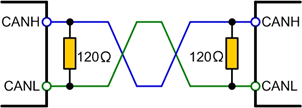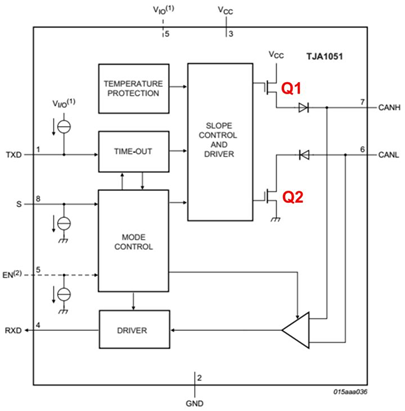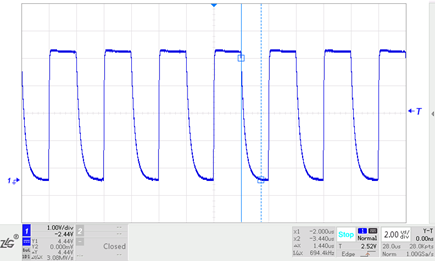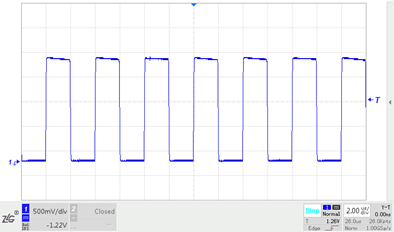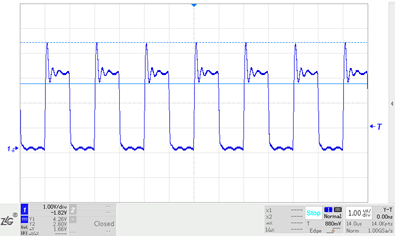The CAN bus terminal resistance is generally 120 ohms. In fact, when designing, there are two 60 ohms resistance stringing, and there are generally two 120Ω nodes on the bus. Basically, people who know a little CAN bus are a little bit. Everyone knows this.
There are three effects of the CAN bus terminal resistance:
1. Improve the anti -interference ability, let the signal of high frequency and low energy go quickly;
2. Ensure that the bus is quickly entered into a hidden state, so that the energy of parasitic capacitors will go faster;
3. Improve the signal quality and place it on both ends of the bus to reduce the reflection energy.
1. Improve anti -interference ability
The CAN bus has two states: “explicit” and “hidden”. “Expressive” represents “0″, “hidden” represents “1″, and is determined by the CAN transceiver. The figure below is a typical internal structure diagram of a CAN transceiver, and the Canh and Canl connection bus.
When the bus is explicit, the internal Q1 and Q2 are turned on, and the pressure difference between the can and the can; when the Q1 and Q2 are cut off, the Canh and Canl are in a passive state with a pressure difference of 0.
If there is no load in the bus, the resistance value of the difference in hidden time is very large. The internal MOS tube is a high -resistance state. External interference only requires a very small energy to enable the bus to enter the explicit (the minimum voltage of the general section of the transceiver. Only 500mv). At this time, if there is a differential model interference, there will be obvious fluctuations on the bus, and there is no place for these fluctuations to absorb them, and it will create an explicit position on the bus.
Therefore, in order to enhance the anti -interference ability of the hidden bus, it can increase a differential load resistance, and the resistance value is as small as possible to prevent the impact of most noise energy. However, in order to avoid excessive current bus to enter the explicit, the resistance value cannot be too small.
2. Ensure quickly entering the hidden state
During the explicit state, the parasitic capacitor of the bus will be charged, and these capacitors need to be discharged when they return to the hidden state. If no resistance load is placed between CANH and Canl, the capacitance can only be poured by the differential resistance inside the transceiver. This impedance is relatively large. According to the characteristics of the RC filter circuit, the discharge time will be significantly longer. We add a 220pf capacitor between the Canh and Canl of the transceiver for analog test. The position rate is 500kbit/s. The waveform is shown in the figure. The decline of this waveform is a relatively long state.
In order to quickly discharge bus parasitic capacitors and ensure that the bus quickly enters the hidden state, a load resistance needs to be placed between CANH and Canl. After adding a 60Ω resistor, the waveforms are shown in the figure. From the figure, the time when explicit returns to recession is reduced to 128ns, which is equivalent to the establishment time of explicitity.
3. Improve signal quality
When the signal is high at a high conversion rate, the signal edge energy will generate signal reflection when the impedance is not matched; the geometric structure of the transmission cable cross section changes, the characteristics of the cable will change then, and the reflection will also cause reflection. Essence
When the energy is reflected, the waveform that causes reflection is superimposed with the original waveform, which will produce bells.
At the end of the bus cable, the rapid changes in impedance cause the signal edge energy reflection, and the bell is generated on the bus signal. If the bell is too large, it will affect the communication quality. A terminal resistor with the same impedance of the cable characteristics can be added to the end of the cable, which can absorb this part of the energy and avoid the generation of bells.
Other people conducted an analog test (the pictures were copied by me), the position rate was 1MBIT/s, the transceiver Canh and Canl connected about 10m twisted lines, and the transistor was connected to the 120Ω resistor to ensure hidden conversion time. No load at the end. The end signal waveform is shown in the figure, and the signal rising edge appears bell.
If a 120Ω resistor is added at the end of the twisted twisted line, the end signal waveform is significantly improved, and the bell disappears.
Generally, in the straight -line topology, both ends of the cable are the sending end and the receiving end. Therefore, one terminal resistance must be added at both ends of the cable.
In the actual application process, the CAN bus is generally not the perfect bus -type design. Many times it is a mixed structure of bus type and star type. The standard structure of analog CAN bus.
Why choose 120Ω?
What is impedance? In electrical science, the obstacle to the current in the circuit is often called impedance. The impedance unit is Ohm, which is often used by Z, which is a plural z = r+i (ωl – 1/(ωc)). Specifically, impedance can be divided into two parts, resistance (real parts) and electric resistance (virtual parts). The electric resistance also includes capacitance and sensory resistance. The current caused by capacitors is called capacitance, and the current caused by the inductance is called sensory resistance. The impedance here refers to the mold of Z.
The characteristic impedance of any cable can be obtained by experiments. On one end of the cable, a square wave generator, the other end is connected to a adjustable resistor, and observes the waveform on the resistance through the oscilloscope. Adjust the size of the resistance value until the signal on the resistance is a good bell -free square wave: impedance matching and signal integrity. At this time, the resistance value can be considered consistent with the characteristics of the cable.
Use two typical cables used by two cars to distort them into twisted lines, and the feature impedance can be obtained by the above method of about 120Ω. This is also the terminal resistance resistance recommended by the CAN standard. Therefore It is not calculated based on the actual line beam characteristics. Of course, there are definitions in the ISO 11898-2 standard.
Why do I have to choose 0.25W?
This must be calculated in combination with some failure status. All interfaces of the car ECU need to consider short -circuit to power and short -circuit to the ground, so we also need to consider the short circuit to the power supply of the CAN bus. According to the standard, we need to consider short circuit to 18V. Assuming that CANH is short to 18V, the current will flow to Canl through terminal resistance, and due The power of the 120Ω resistor is 50mA*50mA*120Ω = 0.3W. Considering the reduction of the amount at high temperature, the power of the terminal resistance is 0.5W.
Post time: Jul-05-2023


